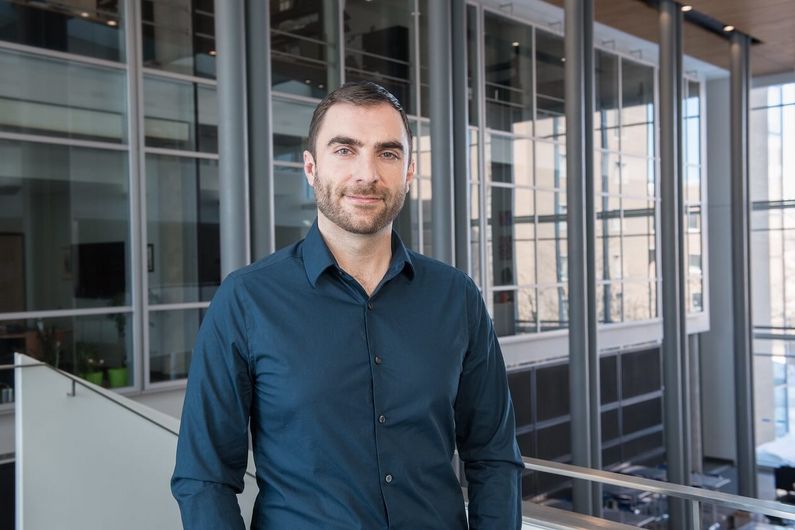Tidying up with the robots
- UdeMNouvelles
04/19/2022
Fresh from postgraduate work in Berkeley, Ca., assistant professor Glen Berseth is pursuing his life’s passion of understanding machines’ intelligence – and making robots clean up around the house.
Glen Berseth has long been fascinated with machines. Growing up, he liked to take them apart to see how they work. Now he likes to make them work for him – and everyone else – through robotics.
Hired last fall as an assistant professor at Université de Montréal after post-doctoral research at the University of California, Berkeley, the 33-year-old wants to help the world go hands-free.
His passion started as a boy, growing up in Ontario and Colorado.
“I would take apart Game Boys, home computers, TVs, vacuums – usually they didn’t work before I got to them, so I wasn’t damaging things what my parents bought,” he recalled.
“I was just really interested in the electronic aspect of how things work.”
Encouraged by his father
One of two sons (the other was into sports, not gadgets), Berseth was encouraged in his hobby by his father, a biology PhD turned software engineer for a large phone company.
“Besides remote-controlled cars, which I got almost every birthday, there was also something called a Radio Shack 300-in-1 Electronic Project Lab,” he said. “It had lots of wires and resistors for things like making light and motion sensors.”
Later, as an undergraduate in computer science at York University, and then as a master’s student there, Berseth got into robotics by helping design a prototype Mars rover that was entered into – and won – several international competiions.
In his Ph.D. work at the University of British Columbia, he switched to a new area – learning systems – trying to control things like simulated robots and actual robots. “It’s like playing a complicated videogame but only using mathematics.”
Then at Berkeley – specifically, at the Berkeley Artificial Intelligence Research Lab – Berseth got busy as a budding expert at the Robotic AI & Learning (RAIL) Lab, supervised by Sergey Levine.
“Montreal is a right fit for me”
Finally, last year, Montreal beckoned.
“There are a few reasons why this place was a right fit for me,” he said. “Being part of the CIFAR program here is very helpful, for one: I can access students a lot faster in order to begin my research.
“UdeM itself was specifically interested in robotics people, and it made me a great offer with a great space for robotics at the school as well as a new building where in a few years we’ll have even more space.
“And teaming up with Mila as well gives me access to a great group of machine-learning people that my students and I can learn from and grow my overall learning direction, which is to use learning algorithms on robots.”
His latest project is a robot that can tidy up around the house, “kind of a vacuum with a robotic arm on the top of it that pick up and put away your kids’ toys or things your cat plays with, like mine does.”
A robot to fold laundry
He has also been working on a robot that folds laundry. “Generally, the idea is to develop robots with more housekeeping abilities, allowing people to have more quality time,” he said.
“It’s so that people can focus more on the things they value in life. Parents could have more fun time with their kids and less time cleaning up after them all the time – that would be great.”
There’s also a practical, academic aspect to robotics: making labs more efficient.
One of the projects Berseth is working on is to automate chemistry experiments, taking the drudgery out of highly skilled students’s chore of physically setting up and doing experiments.
Instead, robots could do the setting-up for them, overnight, and the students would use their working hours to analyze the results – a better, more efficient use of their expertise in interpreting data.
Down the road, Berseth sees himself developing human-like robot systems that not only perform specific tasks but have actual human physical attributes to help them to do so: “hands” with soft “skin” to better grasp objects, for instance.
Auto-feeding the cat
At his new apartment in the Plateau Mont-Royal, he’s set up an automatic feeder to dispense kibble to his cat in the morning, before he gets up from bed. Other automation includes a homemade file server and a lot of voice-to-text.
“I use voice-to text almost all day to answer email and write long comments on research papers,” he said. “I try to avoid physical typing as much as I can.”
His idea of bliss: lying back in his hammock and dictating everything he needs to say in the course of a day, hands-free and worry-free.
In Vancouver, when he was at UBC, he worked on robots in his student apartment. At home in Montreal, he hasn’t started doing that again – nor has he acquired a vacuum robot, yet.
“I’m curious to see how my cat would react to that.”
Media contact
-
Jeff Heinrich
Université de Montréal
Tel: 514 343-7593












